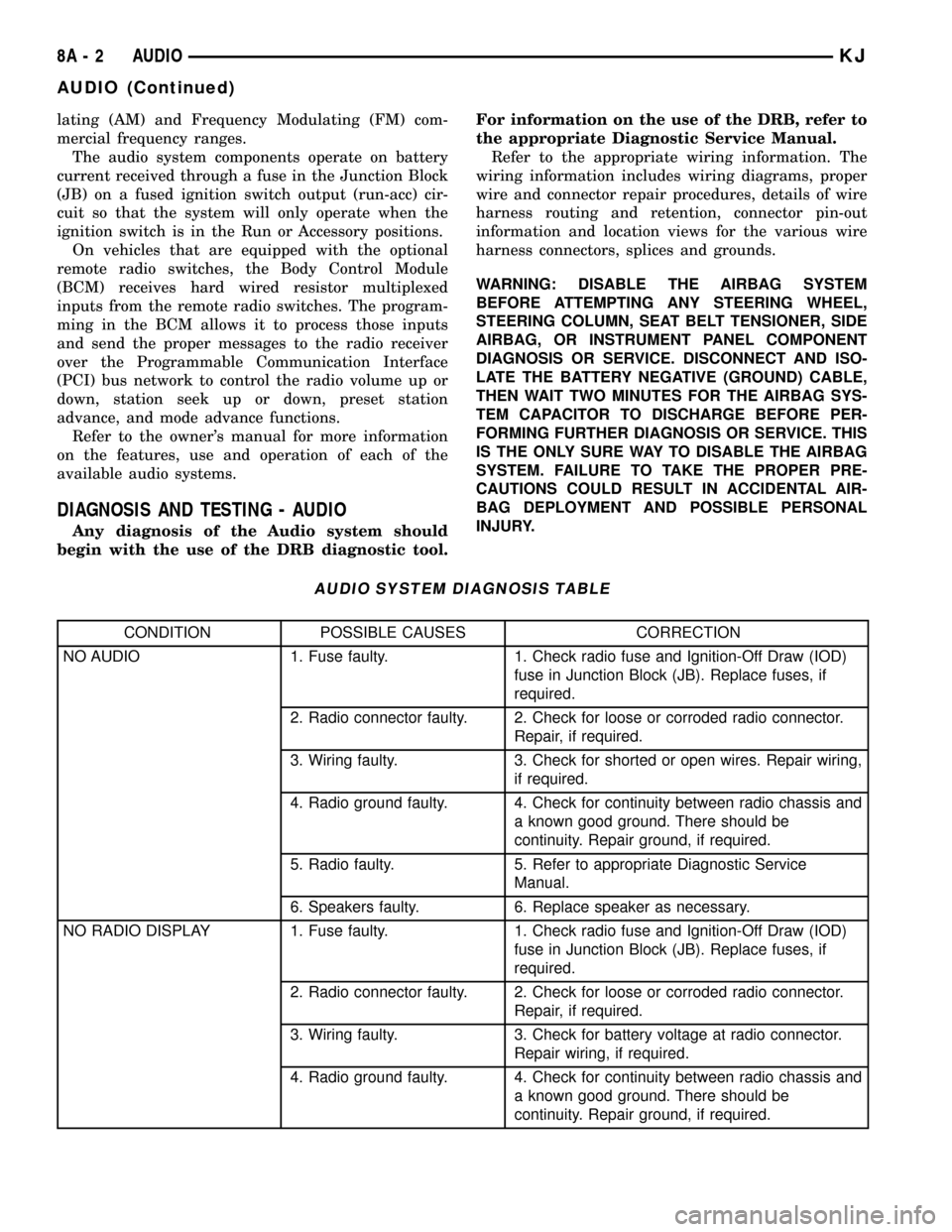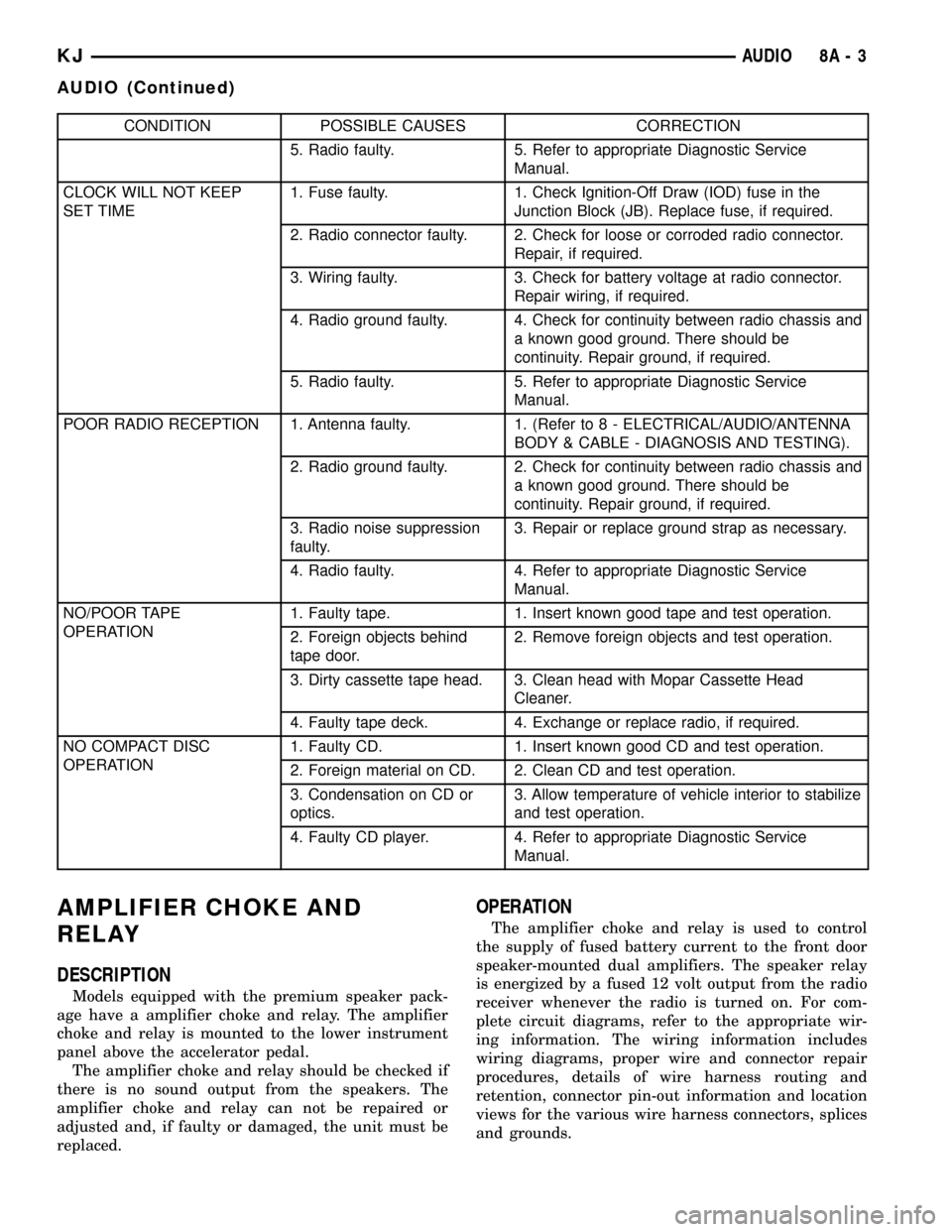Ignition wire JEEP LIBERTY 2002 KJ / 1.G Workshop Manual
[x] Cancel search | Manufacturer: JEEP, Model Year: 2002, Model line: LIBERTY, Model: JEEP LIBERTY 2002 KJ / 1.GPages: 1803, PDF Size: 62.3 MB
Page 278 of 1803

AUDIO
TABLE OF CONTENTS
page page
AUDIO
DESCRIPTION..........................1
OPERATION............................1
DIAGNOSIS AND TESTING - AUDIO..........2
AMPLIFIER CHOKE AND RELAY
DESCRIPTION..........................3
OPERATION............................3
DIAGNOSIS AND TESTING - AMPLIFIER
CHOKE AND RELAY....................4
REMOVAL.............................4
INSTALLATION..........................4
ANTENNA BODY & CABLE
DESCRIPTION..........................4
OPERATION............................5
DIAGNOSIS AND TESTING - ANTENNA BODY
AND CABLE..........................5
REMOVAL.............................6
INSTALLATION..........................6
CD CHANGER
DESCRIPTION..........................7
OPERATION............................7
REMOVAL.............................7
INSTALLATION..........................7
INSTRUMENT PANEL ANTENNA CABLE
REMOVAL.............................7INSTALLATION..........................8
RADIO
DESCRIPTION..........................8
OPERATION............................8
REMOVAL.............................9
INSTALLATION..........................9
RADIO NOISE SUPPRESSION GROUND STRAP
DESCRIPTION..........................9
OPERATION...........................10
REMOVAL.............................10
INSTALLATION.........................11
REMOTE SWITCHES
DESCRIPTION.........................11
OPERATION...........................12
DIAGNOSIS AND TESTING - REMOTE
SWITCHES..........................12
REMOVAL.............................13
INSTALLATION.........................13
SPEAKER
DESCRIPTION.........................13
OPERATION...........................14
REMOVAL.............................14
INSTALLATION.........................15
AUDIO
DESCRIPTION
An audio system is standard factory-installed
equipment on this model. Several combinations of
radio receivers and speaker systems are offered on
this model. The audio system uses an ignition
switched source of battery current so that the system
will only operate when the ignition switch is in the
RUN or ACCESSORY positions.
The audio system includes the following compo-
nents:
²Amplifier choke and relay
²Antenna
²Compact disc changer (if equipped)
²Power amplifier mounted to each front door
speaker (with premium speaker system only)
²Radio noise suppression components
²Radio receiver
²Remote radio switches (if equipped)
²SpeakersCertain functions and features of the audio system
rely upon resources shared with other electronic
modules in the vehicle over the Programmable Com-
munication Interface (PCI) bus network. The data
bus network allows the sharing of sensor informa-
tion. For diagnosis of these electronic modules or of
the data bus network, the use of a DRB scan tool and
the proper Diagnostic Procedures manual are recom-
mended.
Refer to the appropriate wiring information for
complete standard and premium audio system circuit
diagrams. The wiring information includes proper
wire and connector repair procedures, further details
on wire harness routing and retention, as well as
pin-out and location views for the various wire har-
ness connectors, splices, and grounds.
OPERATION
The audio system components are designed to pro-
vide audio entertainment and information through
the reception, tuning and amplification of locally
broadcast radio signals in both the Amplitude Modu-
KJAUDIO 8A - 1
Page 279 of 1803

lating (AM) and Frequency Modulating (FM) com-
mercial frequency ranges.
The audio system components operate on battery
current received through a fuse in the Junction Block
(JB) on a fused ignition switch output (run-acc) cir-
cuit so that the system will only operate when the
ignition switch is in the Run or Accessory positions.
On vehicles that are equipped with the optional
remote radio switches, the Body Control Module
(BCM) receives hard wired resistor multiplexed
inputs from the remote radio switches. The program-
ming in the BCM allows it to process those inputs
and send the proper messages to the radio receiver
over the Programmable Communication Interface
(PCI) bus network to control the radio volume up or
down, station seek up or down, preset station
advance, and mode advance functions.
Refer to the owner's manual for more information
on the features, use and operation of each of the
available audio systems.
DIAGNOSIS AND TESTING - AUDIO
Any diagnosis of the Audio system should
begin with the use of the DRB diagnostic tool.For information on the use of the DRB, refer to
the appropriate Diagnostic Service Manual.
Refer to the appropriate wiring information. The
wiring information includes wiring diagrams, proper
wire and connector repair procedures, details of wire
harness routing and retention, connector pin-out
information and location views for the various wire
harness connectors, splices and grounds.
WARNING: DISABLE THE AIRBAG SYSTEM
BEFORE ATTEMPTING ANY STEERING WHEEL,
STEERING COLUMN, SEAT BELT TENSIONER, SIDE
AIRBAG, OR INSTRUMENT PANEL COMPONENT
DIAGNOSIS OR SERVICE. DISCONNECT AND ISO-
LATE THE BATTERY NEGATIVE (GROUND) CABLE,
THEN WAIT TWO MINUTES FOR THE AIRBAG SYS-
TEM CAPACITOR TO DISCHARGE BEFORE PER-
FORMING FURTHER DIAGNOSIS OR SERVICE. THIS
IS THE ONLY SURE WAY TO DISABLE THE AIRBAG
SYSTEM. FAILURE TO TAKE THE PROPER PRE-
CAUTIONS COULD RESULT IN ACCIDENTAL AIR-
BAG DEPLOYMENT AND POSSIBLE PERSONAL
INJURY.
AUDIO SYSTEM DIAGNOSIS TABLE
CONDITION POSSIBLE CAUSES CORRECTION
NO AUDIO 1. Fuse faulty. 1. Check radio fuse and Ignition-Off Draw (IOD)
fuse in Junction Block (JB). Replace fuses, if
required.
2. Radio connector faulty. 2. Check for loose or corroded radio connector.
Repair, if required.
3. Wiring faulty. 3. Check for shorted or open wires. Repair wiring,
if required.
4. Radio ground faulty. 4. Check for continuity between radio chassis and
a known good ground. There should be
continuity. Repair ground, if required.
5. Radio faulty. 5. Refer to appropriate Diagnostic Service
Manual.
6. Speakers faulty. 6. Replace speaker as necessary.
NO RADIO DISPLAY 1. Fuse faulty. 1. Check radio fuse and Ignition-Off Draw (IOD)
fuse in Junction Block (JB). Replace fuses, if
required.
2. Radio connector faulty. 2. Check for loose or corroded radio connector.
Repair, if required.
3. Wiring faulty. 3. Check for battery voltage at radio connector.
Repair wiring, if required.
4. Radio ground faulty. 4. Check for continuity between radio chassis and
a known good ground. There should be
continuity. Repair ground, if required.
8A - 2 AUDIOKJ
AUDIO (Continued)
Page 280 of 1803

CONDITION POSSIBLE CAUSES CORRECTION
5. Radio faulty. 5. Refer to appropriate Diagnostic Service
Manual.
CLOCK WILL NOT KEEP
SET TIME1. Fuse faulty. 1. Check Ignition-Off Draw (IOD) fuse in the
Junction Block (JB). Replace fuse, if required.
2. Radio connector faulty. 2. Check for loose or corroded radio connector.
Repair, if required.
3. Wiring faulty. 3. Check for battery voltage at radio connector.
Repair wiring, if required.
4. Radio ground faulty. 4. Check for continuity between radio chassis and
a known good ground. There should be
continuity. Repair ground, if required.
5. Radio faulty. 5. Refer to appropriate Diagnostic Service
Manual.
POOR RADIO RECEPTION 1. Antenna faulty. 1. (Refer to 8 - ELECTRICAL/AUDIO/ANTENNA
BODY & CABLE - DIAGNOSIS AND TESTING).
2. Radio ground faulty. 2. Check for continuity between radio chassis and
a known good ground. There should be
continuity. Repair ground, if required.
3. Radio noise suppression
faulty.3. Repair or replace ground strap as necessary.
4. Radio faulty. 4. Refer to appropriate Diagnostic Service
Manual.
NO/POOR TAPE
OPERATION1. Faulty tape. 1. Insert known good tape and test operation.
2. Foreign objects behind
tape door.2. Remove foreign objects and test operation.
3. Dirty cassette tape head. 3. Clean head with Mopar Cassette Head
Cleaner.
4. Faulty tape deck. 4. Exchange or replace radio, if required.
NO COMPACT DISC
OPERATION1. Faulty CD. 1. Insert known good CD and test operation.
2. Foreign material on CD. 2. Clean CD and test operation.
3. Condensation on CD or
optics.3. Allow temperature of vehicle interior to stabilize
and test operation.
4. Faulty CD player. 4. Refer to appropriate Diagnostic Service
Manual.
AMPLIFIER CHOKE AND
RELAY
DESCRIPTION
Models equipped with the premium speaker pack-
age have a amplifier choke and relay. The amplifier
choke and relay is mounted to the lower instrument
panel above the accelerator pedal.
The amplifier choke and relay should be checked if
there is no sound output from the speakers. The
amplifier choke and relay can not be repaired or
adjusted and, if faulty or damaged, the unit must be
replaced.
OPERATION
The amplifier choke and relay is used to control
the supply of fused battery current to the front door
speaker-mounted dual amplifiers. The speaker relay
is energized by a fused 12 volt output from the radio
receiver whenever the radio is turned on. For com-
plete circuit diagrams, refer to the appropriate wir-
ing information. The wiring information includes
wiring diagrams, proper wire and connector repair
procedures, details of wire harness routing and
retention, connector pin-out information and location
views for the various wire harness connectors, splices
and grounds.
KJAUDIO 8A - 3
AUDIO (Continued)
Page 281 of 1803

DIAGNOSIS AND TESTING - AMPLIFIER
CHOKE AND RELAY
Any diagnosis of the Audio system should
begin with the use of the DRB diagnostic tool.
For information on the use of the DRB, refer to
the appropriate Diagnostic Service Manual.
The amplifier choke and relay is used to switch
power to the individual speaker amplifiers used with
the premium speaker package. The amplifier choke
and relay is serviced only as a unit. If all of the
speakers are inoperative the amplifier choke and
relay should be inspected. Before replacement, make
the following inspections of the amplifier choke and
relay circuits. For complete circuit diagrams, refer to
the appropriate wiring information. The wiring infor-
mation includes wiring diagrams, proper wire and
connector repair procedures, details of wire harness
routing and retention, connector pin-out information
and location views for the various wire harness con-
nectors, splices and grounds.
(1)
Check the fused B(+) fuse in the junction block. If
OK, go to Step 2. If not OK, replace the faulty fuse.
(2) Check for battery voltage at the fused B(+) fuse
in the junction block. If OK, go to Step 3. If not OK,
repair the open fused B(+) circuit to the battery as
required.
(3) Disconnect the instrument panel wire harness
connector from the amplifier choke and relay. Check
for battery voltage at the fused B(+) circuit cavity of
the instrument panel wire harness connector for the
amplifier choke and relay. If OK, go to Step 4. If not
OK, repair the open fused B(+) circuit to the junction
block fuse as required.
(4) Probe the ground circuit cavity of the instru-
ment panel wire harness connector for the amplifier
choke and relay. Check for continuity to a good
ground. There should be continuity. If OK, go to Step
5. If not OK, repair the open ground circuit to ground
as required.
(5) Turn the ignition switch to the RUN position
and turn the radio ON. Check for battery voltage at
the radio 12-volt output circuit cavity of the instru-
ment panel wire harness connector for the amplifier
choke and relay. If OK, go to Step 6. If not OK,
repair the open radio 12-volt output circuit to the
radio as required.
(6) Turn the radio and ignition switches to the
OFF position. Reconnect the instrument panel wire
harness connector to the amplifier choke and relay.
Check for battery voltage at the amplified speaker
(+) circuit cavity of the instrument panel wire har-
ness connector for the amplifier choke and relay.
There should be zero volts. Turn the ignition and
radio switches to the ON position. There should now
be battery voltage. If OK, repair the open amplified
speaker (+) circuits to the speaker-mounted amplifi-ers as required. If not OK, replace the faulty ampli-
fier choke and relay.
REMOVAL
(1) Disconnect and isolate the battery negative
cable.
(2) Remove knee blocker cover and knee blocker.
(3) Disconnect the electrical harness connector
from the amplifier choke and relay (Fig. 1).
(4) Remove mounting screws and amplifier choke
and relay.
INSTALLATION
(1) Install the amplifier choke and relay.
(2) Install the mounting screws.
(3) Connect the electrical harness connector.
(4) Install knee blocker cover and knee blocker.
(5) Connect the battery negative cable.
ANTENNA BODY & CABLE
DESCRIPTION
The antenna body and cable is secured below the
fender panel by the antenna cap nut through a
mounting hole in the side of the right front fender.
The primary coaxial antenna cable is then routed
beneath the fender sheet metal and through a entry
hole in the right cowl side panel into the interior of
the vehicle. Inside the vehicle, the primary coaxial
cable is connected to a secondary instrument panel
antenna coaxial cable with an in-line connector that
is located behind the right kick panel. The secondary
coaxial cable is then routed behind the instrument
panel to the back of the radio.
Fig. 1 RADIO CHOKE
1 - RADIO CHOKE
2 - MOUNTING SCREWS
8A - 4 AUDIOKJ
AMPLIFIER CHOKE AND RELAY (Continued)
Page 284 of 1803

(8) Install antenna mast.
(9) Tighten fender mounting bolts near door hinge
area.
(10) Install and tighten the upper fender mounting
bolts (Refer to 23 - BODY/EXTERIOR/FRONT
FENDER - INSTALLATION).
(11) Connect the battery negative cable.
CD CHANGER
DESCRIPTION
A factory-installed Compact Disc (CD) changer fea-
turing a six-CD magazine is an available option on
this model. The CD changer is mounted in the cargo
area of the passenger compartment on the right rear
quarter panel.
The controls on the radio receiver operate the CD
changer through messages sent over the Programma-
ble Communications Interface (PCI) data bus net-
work. For diagnosis of the messaging functions of the
radio receiver and the CD changer, or of the PCI data
bus, a DRB scan tool and the proper Diagnostic Pro-
cedures manual are required.
The CD changer can only be serviced by an autho-
rized radio repair station. See the latest Warranty
Policies and Procedures manual for a current listing
of authorized radio repair stations. Refer to the
appropriate wiring information. The wiring informa-
tion includes wiring diagrams, proper wire and con-
nector repair procedures, details of wire harness
routing and retention, connector pin-out information
and location views for the various wire harness con-
nectors, splices and grounds.
OPERATION
The CD changer will only operate when the igni-
tion switch is in the On or Accessory positions, and
the radio is turned on. The six-CD magazine may be
ejected with the ignition in the Off position. For more
information on the features, loading procedures and
radio control functions for the operation of the CD
changer, refer to the owner's manual.
REMOVAL
(1) Disconnect and isolate the battery negative
cable.
(2) Remove the right rear quarter trim panel.
(Refer to 23 - BODY/INTERIOR/QUARTER TRIM
PANEL - REMOVAL).
(3) Disconnect the electrical wire harness connec-
tor (Fig. 4).
(4) Remove the mounting nuts.
(5) Remove the CD Changer from the vehicle.
INSTALLATION
(1) Install the CD Changer to the vehicle.
(2) Install the mounting nuts. Tighten to 11.8 N´m
(104 in. lbs.).
(3) Connect the wire harness connector.
(4) Install the right rear quarter trim panel (Refer
to 23 - BODY/INTERIOR/QUARTER TRIM PANEL -
INSTALLATION).
(5) Connect the battery negative cable.
INSTRUMENT PANEL
ANTENNA CABLE
REMOVAL
WARNING: DISABLE THE AIRBAG SYSTEM
BEFORE ATTEMPTING ANY STEERING WHEEL,
STEERING COLUMN, SEAT BELT TENSIONER, SIDE
AIRBAG, OR INSTRUMENT PANEL COMPONENT
DIAGNOSIS OR SERVICE. DISCONNECT AND ISO-
LATE THE BATTERY NEGATIVE (GROUND) CABLE,
THEN WAIT TWO MINUTES FOR THE AIRBAG SYS-
TEM CAPACITOR TO DISCHARGE BEFORE PER-
FORMING FURTHER DIAGNOSIS OR SERVICE. THIS
IS THE ONLY SURE WAY TO DISABLE THE AIRBAG
SYSTEM. FAILURE TO TAKE THE PROPER PRE-
CAUTIONS COULD RESULT IN ACCIDENTAL AIR-
BAG DEPLOYMENT AND POSSIBLE PERSONAL
INJURY.
(1) Disconnect and isolate the battery negative
cable.
Fig. 4 CD CHANGER
1 - CD CHANGER
2 - WIRE HARNESS CONNECTOR
3 - MOUNTING NUT
KJAUDIO 8A - 7
ANTENNA BODY & CABLE (Continued)
Page 285 of 1803

(2) Remove the instrument panel (Refer to 23 -
BODY/INSTRUMENT PANEL/INSTRUMENT
PANEL ASSEMBLY - REMOVAL).
(3) Disconnect the antenna cable from radio by
pulling the locking antenna connector away from
radio (Fig. 5).
(4) Disengage each of the retainers that secure the
cable to the instrument panel (Fig. 6).
(5) Remove the cable from the instrument panel.
INSTALLATION
WARNING: DISABLE THE AIRBAG SYSTEM
BEFORE ATTEMPTING ANY STEERING WHEEL,STEERING COLUMN, SEAT BELT TENSIONER, SIDE
AIRBAG, OR INSTRUMENT PANEL COMPONENT
DIAGNOSIS OR SERVICE. DISCONNECT AND ISO-
LATE THE BATTERY NEGATIVE (GROUND) CABLE,
THEN WAIT TWO MINUTES FOR THE AIRBAG SYS-
TEM CAPACITOR TO DISCHARGE BEFORE PER-
FORMING FURTHER DIAGNOSIS OR SERVICE. THIS
IS THE ONLY SURE WAY TO DISABLE THE AIRBAG
SYSTEM. FAILURE TO TAKE THE PROPER PRE-
CAUTIONS COULD RESULT IN ACCIDENTAL AIR-
BAG DEPLOYMENT AND POSSIBLE PERSONAL
INJURY.
(1) Position the instrument panel antenna cable
onto the instrument panel.
(2) Engage each of the retainers that secure the
cable to the back side of the instrument panel.
(3) Connect cable to radio.
(4) Install instrument panel (Refer to 23 - BODY/
INSTRUMENT PANEL/INSTRUMENT PANEL
ASSEMBLY - INSTALLATION).
(5) Connect the battery negative cable.
RADIO
DESCRIPTION
Available factory-installed radio receivers for this
model include an AM/FM/cassette with CD changer
control feature (RBB sales code), an AM/FM/cassette/
CD/graphic equalizer with CD changer control fea-
ture (RBP sales code), or an AM/FM/CD/ with CD
changer control feature (RBK sales code). All factory-
installed radio receivers can communicate on the
Programmable Communications Interface (PCI) data
bus network. All factory-installed receivers are stereo
Electronically Tuned Radios (ETR) and include an
electronic digital clock function.
These radio receivers can only be serviced by an
authorized radio repair station. See the latest War-
ranty Policies and Procedures manual for a current
listing of authorized radio repair stations.
OPERATION
The radio receiver operates on ignition switched
battery current that is available only when the igni-
tion switch is in the On or Accessory positions. The
electronic digital clock function of the radio operates
on fused battery current supplied through the IOD
fuse, regardless of the ignition switch position.
For more information on the features, setting pro-
cedures, and control functions for each of the avail-
able factory-installed radio receivers, refer to the
owner's manual. For complete circuit diagrams, refer
to the appropriate wiring information. The wiring
information includes wiring diagrams, proper wire
and connector repair procedures, details of wire har-
Fig. 5 ANTENNA TO RADIO
1 - RADIO
2 - LOCKING ANTENNA CONNECTOR
3 - INSTRUMENT PANEL ANTENNA CABLE
Fig. 6 INSTRUMENT PANEL ANTENNA CABLE
1 - INSTRUMENT PANEL ANTENNA CABLE
2 - ANTENNA BODY AND CABLE
8A - 8 AUDIOKJ
INSTRUMENT PANEL ANTENNA CABLE (Continued)
Page 289 of 1803

OPERATION
The six switches in the two remote radio switch units
are normally open, resistor multiplexed momentary
switches that are hard wired to the Body Control Mod-
ule (BCM) through the clockspring. The BCM sends a
five volt reference signal to both switch units on one
circuit, and senses the status of all of the switches by
reading the voltage drop on a second circuit.
When the BCM senses an input (voltage drop) from
any one of the remote radio switches, it sends the
proper switch status messages on the Programmable
Communication Interface (PCI) data bus network to
the radio receiver. The electronic circuitry within the
radio receiver is programmed to respond to these
remote radio switch status messages by adjusting the
radio settings as requested. For diagnosis of the
BCM or the PCI data bus, the use of a DRB scan tool
and the proper Diagnostic Procedures manual are
recommended.
For more information on the features and control
functions for each of the remote radio switches, refer
to the owner's manual.
DIAGNOSIS AND TESTING - REMOTE
SWITCHES
Any diagnosis of the Audio system should
begin with the use of the DRB diagnostic tool.
For information on the use of the DRB, refer to
the appropriate Diagnostic Service Manual.
For complete circuit diagrams, refer to the appro-
priate wiring information. The wiring information
includes wiring diagrams, proper wire and connector
repair procedures, details of wire harness routing
and retention, connector pin-out information and
location views for the various wire harness connec-
tors, splices and grounds.
WARNING: DISABLE THE AIRBAG SYSTEM
BEFORE ATTEMPTING ANY STEERING WHEEL,
STEERING COLUMN, SEAT BELT TENSIONER, SIDE
AIRBAG, OR INSTRUMENT PANEL COMPONENT
DIAGNOSIS OR SERVICE. DISCONNECT AND ISO-
LATE THE BATTERY NEGATIVE (GROUND) CABLE,
THEN WAIT TWO MINUTES FOR THE AIRBAG SYS-
TEM CAPACITOR TO DISCHARGE BEFORE PER-
FORMING FURTHER DIAGNOSIS OR SERVICE. THIS
IS THE ONLY SURE WAY TO DISABLE THE AIRBAG
SYSTEM. FAILURE TO TAKE THE PROPER PRE-
CAUTIONS COULD RESULT IN ACCIDENTAL AIR-
BAG DEPLOYMENT AND POSSIBLE PERSONAL
INJURY.
(1) Disconnect and isolate the battery negative
cable. Remove the remote radio switch(es) (Fig. 14)
from the steering wheel (Refer to 8 - ELECTRICAL/
AUDIO/REMOTE SWITCHES - REMOVAL).(2)
Use an ohmmeter to check the switch resis-
tances as shown in the Remote Radio Switch Test
chart. If the remote radio switch resistances check OK,
go to Step 3. If not OK, replace the faulty switch.
REMOTE RADIO SWITCH TEST TABLE
Switch Switch Position Resistance
Right
(White)Volume Up 1.210 Kilohms 1%
Right
(White)Volume Down 3.010 Kilohms 1%
Right
(White)Mode Advance 0.0511 Kilohms 1%
Left
(Black)Seek Up 0.261 Kilohms 1%
Left
(Black)Seek Down 0.681 Kilohms 1%
Left
(Black)Pre-Set Station
Advance0.162 Kilohms 1%
(3) Reconnect the battery negative cable. Turn the
ignition switch to the On position. Check for 5 volts
at the radio control mux circuit cavities of the steer-
ing wheel wire harness connectors for both remote
radio switches. If OK, go to Step 4. If not OK, repair
the open or shorted radio control mux circuit to the
Body Control Module (BCM) as required.
(4) Disconnect and isolate the battery negative
cable. Disconnect the 22-way instrument panel wire
harness connector from the BCM. Check for continu-
ity between the remote radio switch ground circuit
cavities of the steering wheel wire harness connec-
tors for both remote radio switches and a good
Fig. 14 Remote Radio Switches
1 - BLACK (LEFT) SWITCH
2 - WHITE (RIGHT) SWITCH
8A - 12 AUDIOKJ
REMOTE SWITCHES (Continued)
Page 295 of 1803

A chime warning system is standard factory-in-
stalled equipment on this model. The chime warning
system uses a single chime tone generator that is sol-
dered onto the electronic circuit board that is integral
to the ElectroMechanical Instrument Cluster (EMIC)
to provide an audible indication of various vehicle
conditions that may require the attention of the vehi-
cle operator or occupants (Fig. 1). The microproces-
sor-based EMIC utilizes electronic chime request
messages received from other electronic modules in
the vehicle over the Programmable Communications
Interface (PCI) data bus network along with hard
wired inputs to the cluster microprocessor to monitor
many sensors and switches throughout the vehicle.
In response to those inputs, the integrated circuitry
and internal programming of the EMIC allow it to
control audible outputs that are produced through its
on-board chime tone generator.
The EMIC circuitry and its chime tone generator
are capable of producing each of the four following
audible outputs:
²Fixed Duration Beep- A short, sharp, single
tactile ªbeep-likeº tone that is about 150 milliseconds
in duration.
²Single Chime Tone- A single ªbong-likeº chime
tone.
²Slow Rate Repetitive Chime- Repeated
chime tones that are issued at a slow rate of about
50 ªbong-likeº tones per minute.
²Fast Rate Repetitive Chime- Repeated chime
tones that are issued at a fast rate of about 180
ªbong-likeº tones per minute.
Hard wired circuitry connects the EMIC and the
various chime warning system switch and sensor
inputs to their electronic modules and to each other
through the electrical system of the vehicle. These
hard wired circuits are integral to numerous wire
harnesses, which are routed throughout the vehicle
and retained by many different methods. These cir-
cuits may be connected to each other, to the vehicle
electrical system and to the chime warning system
through the use of a combination of soldered splices,
splice block connectors, and many different types of
wire harness terminal connectors and insulators.
Refer to the appropriate wiring information. The wir-
ing information includes wiring diagrams, proper
wire and connector repair procedures, further details
on wire harness routing and retention, as well as
pin-out and location views for the various wire har-
ness connectors, splices and grounds.
The EMIC chime warning system circuitry and
integral chime tone generator cannot be adjusted or
repaired. If the EMIC or the chime tone generator
are damaged or faulty, the EMIC unit must be
replaced.OPERATION
The chime warning system is designed to provide
an audible output as an indication of various condi-
tions that may require the attention or awareness of
the vehicle operator or occupants. The chime warning
system components operate on battery current
received through a fused B(+) fuse in the Junction
Block (JB) on a non-switched fused B(+) circuit so
that the system may operate regardless of the igni-
tion switch position. However, the chime warning
system also monitors the ignition switch position so
that some chime features will only occur with igni-
tion switch in the On position, while others occur
regardless of the ignition switch position.
The chime warning system provides an audible
indication to the vehicle operator or occupants under
the following conditions:
²Airbag Indicator Warning- The ElectroMe-
chanical Instrument Cluster (EMIC) chime tone gen-
erator will generate one, short, ªbong-likeº chime
tone when the ignition switch is in the On position,
and an electronic message is received over the Pro-
grammable Communications Interface (PCI) data bus
from the Airbag Control Module (ACM) requesting
ªAirbagº indicator illumination. This warning will
only occur following completion of the ªAirbagº indi-
cator bulb test, and will only occur once during an
ignition cycle. The ACM uses internal programming,
hard wired inputs from the front Supplemental
Restraint System (SRS) components and, on vehicles
so equipped, electronic messages received over the
PCI data bus from each Side Impact Airbag Control
Module (SIACM) to determine the proper ªAirbagº
indicator messages to send to the EMIC.
²Anti-Lock Brake Indicator Warning- The
EMIC chime tone generator will generate one, short,
ªbong-likeº chime tone when the ignition switch is in
the On position, and an electronic message is
received over the PCI data bus from the Controller
Anti-lock Brake (CAB) requesting ªAntilock Brake
System (ABS)º indicator illumination. This warning
will only occur following completion of the ªABSº
indicator bulb test, and will only occur once during
an ignition cycle. The CAB uses internal program-
ming, hard wired inputs from the Antilock Brake
System (ABS) components, and electronic messages
received over the PCI data bus from the Powertrain
Control Module (PCM) to determine the proper
ªABSº indicator messages to send to the EMIC.
²Compass Mini-Trip Computer Reset- The
EMIC chime tone generator will generate one, short,
fixed duration ªbeep-likeº chime tone when the igni-
tion switch is in the On position, and an electronic
message is received over the PCI data bus from the
optional Compass Mini-Trip Computer (CMTC)
requesting that the CMTC elapsed time, average fuel
8B - 2 CHIME/BUZZERKJ
CHIME WARNING SYSTEM (Continued)
Page 296 of 1803

economy, and/or trip odometer data has been reset.
The CMTC uses internal programming, hard wired
inputs from the U.S./Metric and Reset switches, and
electronic messages received from the Body Control
Module (BCM) to determine the proper reset mes-
sages to send to the EMIC.
²Door Ajar Warning- The EMIC chime tone
generator will generate a single ªbong-likeº chime
tone when the ignition switch is in the On position,
and electronic messages are received over the PCI
data bus from the Body Control Module (BCM) indi-
cating that the status of any door ajar input has
changed from closed to not closed, and from the PCM
indicating that the vehicle is moving. The BCM uses
internal programming, and hard wired inputs from
the door ajar switches and the ignition switch to
determine the proper door ajar switch messages to
send to the EMIC. The PCM uses internal program-
ming and a hard wired vehicle speed pulse input
received from the BCM to determine the proper vehi-
cle distance messages to send to the EMIC.
²Electrical System Voltage Low or High
Warning- Each time the ignition switch is turned to
the On position, the EMIC chime tone generator will
generate a single ªbong-likeº chime tone the first
time an electronic message is received over the PCI
data bus from the PCM requesting ªChargingº indi-
cator illumination. This warning would indicate that
the monitored electrical system voltage is either too
low or too high. This warning will only occur once
during an ignition cycle. The PCM uses internal pro-
gramming and hard wired inputs from the electrical
and charging systems to determine the proper
ªChargingº indicator messages to send to the EMIC.
²Engine Coolant Temperature High Warning
- Each time the ignition switch is turned to the On
position, the EMIC chime tone generator will gener-
ate ªbong-likeº chime tones the first time an elec-
tronic message is received over the PCI data bus
from the PCM indicating that the engine coolant
temperature is too high. This chime will sound for
five consecutive single tones, unless an electronic
message is received from the PCM indicating that
the engine coolant temperature is not too high, or
unless the ignition switch is turned to the Off posi-
tion before the five single tones have completed. The
PCM uses internal programming and a hard wired
input from the engine coolant temperature sensor to
determine the proper engine coolant temperature
messages to send to the EMIC.
²Engine Oil Pressure Low Warning- Each
time the ignition switch is turned to the On position,
the EMIC chime tone generator will generate a sin-
gle ªbong-likeº chime tone the first time three
sequential sets of electronic messages are received
over the PCI data bus from the PCM indicating thatthe engine oil pressure is too low with the engine
running. The PCM uses internal programming and
hard wired inputs from the oil pressure sensor and
the crankshaft position sensor to determine the
proper oil pressure and engine speed messages to
send to the EMIC.
²Fasten Seat Belt Warning- Each time the
ignition switch is turned to the On position, the
EMIC chime tone generator will generate repetitive
ªbong-likeº chime tones at a slow rate the first time
an electronic message is received over the PCI data
bus from the ACM requesting ªSeatbeltº indicator
illumination. The ACM uses internal programming
and hard wired inputs from the driver side front seat
belt switch and the ignition switch to determine that
the driver side front seat belt is not fastened with
the ignition switch in the On position. These chimes
will continue to sound for a duration of about six sec-
onds each time the ignition switch is turned to the
On position, or until the driver side front seat belt is
fastened, whichever occurs first. This audible warn-
ing occurs independent of the visual warning pro-
vided by the EMIC ªSeatbeltº indicator.
²Gate Ajar Warning- The EMIC chime tone
generator will generate a single ªbong-likeº chime
tone when the ignition switch is in the On position,
and electronic messages are received over the PCI
data bus from the BCM indicating that the status of
the tailgate ajar input has changed from closed to
not closed, and from the PCM indicating that the
vehicle is moving. The BCM uses internal program-
ming, and hard wired inputs from the tailgate ajar
switch and the ignition switch to determine the
proper tailgate ajar switch messages to send to the
EMIC. The PCM uses internal programming and a
hard wired vehicle speed pulse input received from
the BCM to determine the proper vehicle distance
messages to send to the EMIC.
²Glass Ajar Warning- The EMIC chime tone
generator will generate a single ªbong-likeº chime
tone when the ignition switch is in the On position,
and electronic messages are received over the PCI
data bus from the BCM indicating that the status of
the rear flip-up glass ajar input has changed from
closed to not closed, and from the PCM indicating
that the vehicle is moving. The BCM uses internal
programming, and hard wired inputs from the flip-up
glass ajar switch and the ignition switch to deter-
mine the proper flip-up glass ajar switch messages to
send to the EMIC. The PCM uses internal program-
ming and a hard wired vehicle speed pulse input
received from the BCM to determine the proper vehi-
cle distance messages to send to the EMIC.
²Head/Park/Fog Lights-On Warning- The
EMIC chime tone generator will generate repetitive
ªbong-likeº chime tones at a fast rate when the igni-
KJCHIME/BUZZER 8B - 3
CHIME WARNING SYSTEM (Continued)
Page 297 of 1803

tion switch is in any position except On, and elec-
tronic messages are received over the PCI data bus
from the BCM indicating that the exterior lights are
On with the ignition switch in any position except
On, and the status of the driver side front door is not
closed. The BCM uses internal programming and
hard wired inputs from the left (lighting) control
stalk of the multi-function switch, the ignition
switch, and the driver side front door ajar switch to
determine the proper messages to send to the EMIC.
These chimes will continue to sound until the exte-
rior lighting is turned Off, until the ignition switch is
turned to the On position, or until the status of the
driver side front door ajar input changes from not
closed to closed, whichever occurs first.
²Key-In-Ignition Warning- The EMIC chime
tone generator will generate repetitive ªbong-likeº
chime tones at a fast rate when the ignition switch is
in any position except On, and electronic messages
are received over the PCI data bus from the BCM
indicating that the key is in the ignition lock cylinder
with the ignition switch in any position except On,
and the driver side front door is not closed. The BCM
internal programming and hard wired inputs from
the key-in ignition circuitry of the ignition switch,
the ignition switch, and the driver side front door
ajar switch to determine the proper messages to send
to the EMIC. These chimes will continue to sound
until the key is removed from the ignition lock cylin-
der, until the ignition switch is turned to the On
position, or until the status of the driver side front
door ajar input changes from not closed to closed,
whichever occurs first.
²Low Coolant Warning- On vehicles equipped
with a diesel engine, the EMIC chime tone generator
will generate a single ªbong-likeº chime tone when
the ignition switch is first turned to the On position
and a hard wired input from the engine coolant level
sensor to the EMIC indicates that the coolant level is
low for more than about one-quarter second. Any
time after the ignition switch is first turned to the
On position, the EMIC uses internal programming to
check the status of the engine coolant level sensor
inputs about once every second, then adjusts an
internal counter up or down based upon the status of
this input. When the counter accumulates thirty
inputs indicating that the coolant level is low, a sin-
gle chime tone is sounded. This strategy is intended
to reduce the effect that coolant sloshing within the
coolant reservoir can have on reliable chime warning
operation. This warning will only occur once during
an ignition cycle.
²Low Fuel Warning- Each time the ignition
switch is turned to the On position, the EMIC chime
tone generator will generate a single ªbong-likeº
chime tone the first time an electronic message isreceived over the PCI data bus from the PCM
requesting ªLow Fuelº indicator illumination. The
chime will only occur a second time during the same
ignition cycle if another electronic message has been
received from the PCM indicating that there is an
increase in the fuel level equal to about 3 liters (0.8
gallon), then a subsequent electronic message from
the PCM requests ªLow Fuelº indicator illumination.
This strategy combined with filtering performed by
the internal programming of the PCM on the fuel
tank sending unit input is intended to reduce the
possibility of fuel sloshing within the fuel tank caus-
ing multiple low fuel warning chimes during a given
ignition cycle. The EMIC will also respond with the
low fuel warning chime when electronic fuel level
messages are received from the PCM indicating that
the hard wired input to the PCM from the fuel tank
sending unit is an open circuit (greater than full), or
a short circuit (less than empty).
²Low Washer Fluid Warning- The EMIC
chime tone generator will generate a single ªbong-
likeº chime tone when the ignition switch is turned
to the On position and a hard wired input from the
washer fluid level switch to the EMIC indicates the
washer fluid is low for more than about one-quarter
second. Any time after the ignition switch is first
turned to the On position, the EMIC uses internal
programming to check the status of the washer fluid
level switch inputs about once every second, then
adjusts an internal counter up or down based upon
the status of this input. When the counter accumu-
lates thirty inputs indicating that the washer fluid
level is low, a single chime tone is sounded. This
strategy is intended to reduce the effect that fluid
sloshing within the washer reservoir can have on
reliable chime warning operation. This warning will
only occur once during an ignition cycle.
²Overspeed Warning- The EMIC chime tone
generator will generate repetitive ªbong-likeº chime
tones at a slow rate when the ignition switch is in
the On position, and an electronic message received
over the PCI data bus from the PCM indicates that
the vehicle speed is over a programmed speed value.
The PCM uses internal programming and distance
pulse information received over a hard wired vehicle
speed pulse input from the BCM to determine the
proper vehicle speed messages to send to the EMIC.
The BCM uses an internally programmed electronic
pinion factor and a hard wired input from the rear
wheel speed sensor to calculate the proper distance
pulse information to send to the PCM. The electronic
pinion factor represents the proper tire size and axle
ratio information for the vehicle. These chimes will
continue to sound until the vehicle speed messages
are below the programmed speed value, or until the
ignition switch is turned to the Off position, which-
8B - 4 CHIME/BUZZERKJ
CHIME WARNING SYSTEM (Continued)